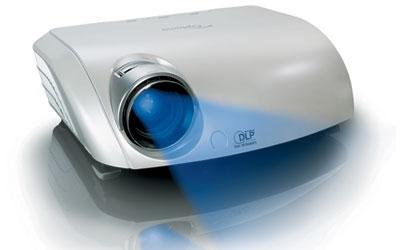Optoma HD80 1080p DLP Front Projector

 Although prices for 1080p LCD front projectors have dropped steadily this past year, models that use the competing DLP and LCoS technologies have continued to command a big premium over their liquid-crystal brethren. But it was only a matter of time until DLP models dipped below the $3,000 mark that most LCD models sell at - and with the release of the Optoma HD80 1080p DLP front projector, that big moment has finally arrived. At $2,699, the HD80 is currently the lowest-priced 1080p DLP front projector on the market.
Although prices for 1080p LCD front projectors have dropped steadily this past year, models that use the competing DLP and LCoS technologies have continued to command a big premium over their liquid-crystal brethren. But it was only a matter of time until DLP models dipped below the $3,000 mark that most LCD models sell at - and with the release of the Optoma HD80 1080p DLP front projector, that big moment has finally arrived. At $2,699, the HD80 is currently the lowest-priced 1080p DLP front projector on the market.
The sleek lines of the projector's curved white case lend it considerable visual appeal - unusual for a low-price model. There's a control panel on top for switching inputs and navigating menus, but Optoma obviously skimped on installation features to hit the HD80's low price. There's no vertical or horizontal lens shift, and both the zoom and focus controls are manual. On the other hand, the 6x speed, 7-segment color wheel creates full color from the projector's single 1,920 x 1,080-pixel DLP chip with only minimal rainbow artifacts, which I confirmed during testing. Although there's no auto iris on the HD80, it does have a manual iris control to extract deeper blacks. Lamp life is rated at 3,000 hours in standard mode.
Inputs on the HD80 include two HDMI, one DVI, and one component-video. There's no VGA connection, but you could use the DVI input for a PC. I'd say the projector's cleanly labeled, backlit remote is an exemplary design, providing one-touch access to key picture adjustments and direct buttons for selecting sources and aspect ratio. While I'm on the subject, the HD80's aspect-ratio modes, all of which are selectable for both standard- and high-def inputs, include 4:3, 16:9, Letterbox, and a Native option that displays the signal as-is with no scaling.
SETUP When I mentioned that the Optoma's installation features seem stripped down, I wasn't kidding. The lack of a lens-shift function, in particular, made initial setup of the HD80 kind of primitive compared with that of other projectors I've had in my shop recently. Image offset is 136% of the screen height. And with a 100-inch-diagonal screen, the 1.2x zoom lens allowed for a placement range of only 13.5 to 16 feet - a tight squeeze. On the plus side, the HD80 can be outfitted with an anamorphic lens for use with an ultra-wide 2.35:1 screen, a way-cool perk.
The projector offers a Brite lamp mode to boost light output. But selecting this also boosted fan noise, which was already relatively high in the standard lamp mode. Similarly, the projector's Image AI setting, which automatically switches lamp modes based on the signal content, also periodically increased fan noise. Since the HD80's image was bright and punchy enough without it, I left it off.
Each of the HD80's five picture presets can be tweaked for each input, although I discovered that both HDMI inputs shared the same User picture memory. Of the three color-temperature settings, Warm delivered the most accurate and natural-looking color. (A User color temperature with advanced adjustments is also available.) Strangely, some of the picture-setup features described in the HD80's manual turned out to be missing from its menus, among them a Film Mode setting. This feature, which Optoma hopes to enable in a future firmware upgrade, would allow the projector to display a 1080p/24-frame-per-second signal from a high-def disc player at 48 Hz, as opposed to the current 60-Hz refresh rate for a 1080p/24 input. Of the features that could be found on the HD80, the manual iris was the one I took greatest advantage of during viewing.













































